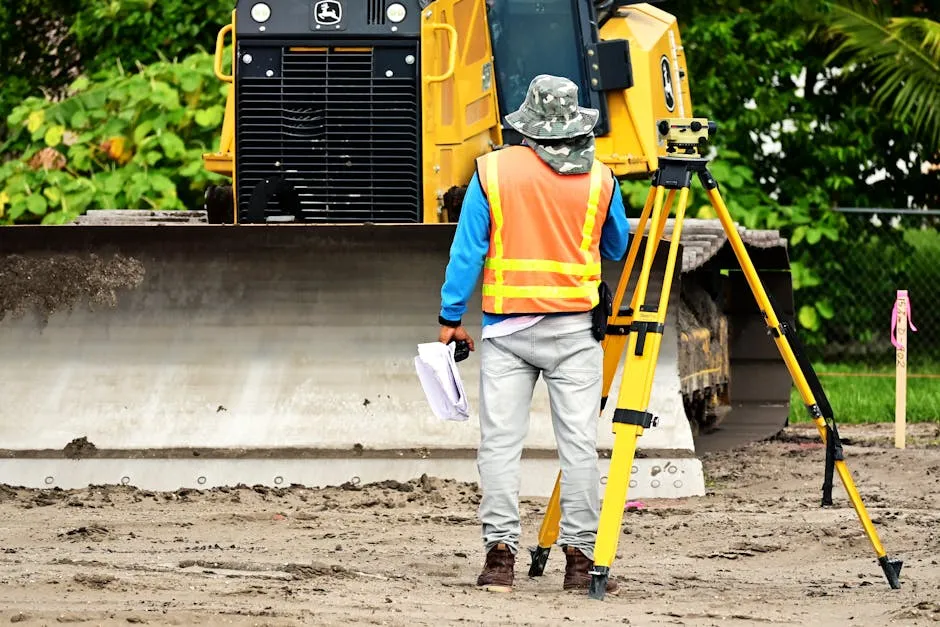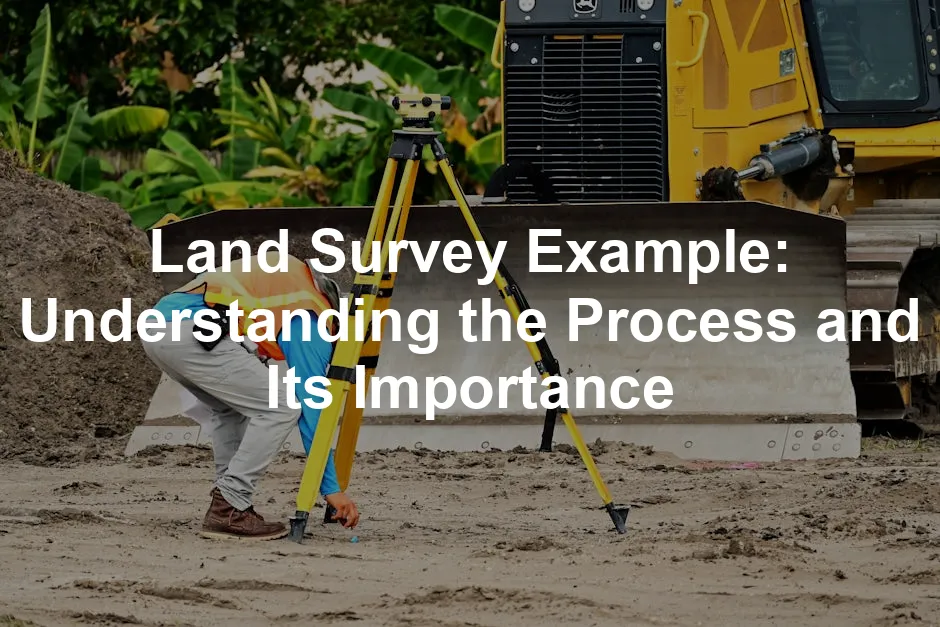Introduction
A land survey measures and maps property boundaries. It plays a vital role in property ownership and development. This article focuses on various land survey examples and types, helping you understand their significance.
For those looking to get started in land surveying, consider investing in a Surveying Equipment Set. This handy kit contains all the essential tools you’ll need to measure and mark boundaries accurately, making your surveying tasks a breeze!
Summary and Overview
Land surveys are essential in numerous sectors, including real estate, construction, and environmental studies. They provide crucial information about property boundaries, dimensions, and features. Understanding land surveys helps avoid disputes, ensures compliance with regulations, and facilitates informed decision-making.

Several types of surveys exist, each serving a specific purpose. For instance, boundary surveys confirm property lines, while topographic surveys detail land contours and elevations. Knowing these types is vital for potential homeowners, developers, and landowners. Awareness of land surveys can save time and money, making it an important topic for anyone involved in property transactions or development projects.
Understanding the importance of land surveys can provide clarity on property boundaries and prevent disputes. land survey example
Types of Land Surveys
ALTA/NSPS Land Title Surveys
ALTA/NSPS Land Title Surveys are comprehensive surveys required for title insurance purposes. They follow strict standards set by the American Land Title Association (ALTA) and the National Society of Professional Surveyors (NSPS). These regulations ensure that lenders and developers receive consistent, reliable information about a property.

Lenders often require these surveys to confirm property boundaries, easements, and potential encroachments. They play a crucial role in real estate transactions, as they help prevent disputes and protect investments. Developers also rely on these surveys to understand land characteristics, ensuring that their projects comply with local regulations.
Typically, the completion timeline for ALTA surveys ranges from a few weeks to several months. The duration depends on property size and complexity. Interestingly, around 85% of commercial properties require this type of survey before any transactions take place. This statistic highlights its importance in the real estate sector.
Boundary Surveys
Boundary Surveys are essential for identifying property lines and corners. They utilize both fieldwork and record research to establish legal boundaries. Surveyors often employ advanced technology, like GPS, alongside traditional methods to ensure accuracy.

Legal implications arise from boundary identification. Misunderstandings about property lines can lead to disputes between neighbors. In fact, approximately 75% of property disputes are resolved through boundary surveys. This emphasizes their role in maintaining peace among property owners.
Boundary surveys are particularly useful when buying or selling land. They provide clarity before any transactions occur, preventing costly legal battles later. Homeowners may also need them when planning renovations that could affect property lines. By knowing exact boundaries, you can avoid encroachments and ensure compliance with local zoning laws.
To enhance your boundary determination process, you might also want to check out a set of Property Boundary Marker Flags. These flags can help you mark boundaries clearly and avoid misunderstandings with neighbors.
Understanding these survey types equips you with knowledge necessary for successful property dealings.
Topographic Surveys
Topographic surveys focus on mapping natural and man-made features of the land. They capture essential details like elevations, contours, and existing structures. This data is vital for construction and environmental assessments.

In construction, these surveys guide project planning. Engineers and architects use them to design structures that fit the landscape. Meanwhile, environmental assessments utilize topographic data to evaluate land use and potential impacts.
Surveying techniques vary, with aerial mapping becoming popular. Drones equipped with cameras provide efficient, high-resolution images. Ground-based methods, like total stations, also play a significant role in gathering precise measurements.
Topographic surveys are crucial in landscape design. They help create visually appealing and functional outdoor spaces. Incorporating natural features enhances the overall design while ensuring compliance with local regulations.
The average cost of topographic surveys can range significantly. Generally, expect to pay between $500 to $2,000, depending on the property’s size and complexity. This investment is often worthwhile for the valuable insights gained.
If you’re interested in taking your surveying to the next level, consider investing in a Aerial Surveying Drone. This gadget can make capturing topographic data a whole lot easier and way more fun!
Construction Surveys
Construction surveys are essential for staking out proposed structures on a site. They ensure that projects adhere to plans and specifications. By identifying exact locations for buildings, roads, and utilities, these surveys minimize costly errors.

In the construction process, these surveys play a critical role. They provide a foundation to guide construction teams, ensuring accurate placement of structures. This helps avoid future complications, saving both time and money.
There are two main types of construction surveys: preliminary and as-built. Preliminary surveys are conducted before construction begins, while as-built surveys document what has been constructed. The latter is crucial for record-keeping and verifying compliance with design plans.
It’s interesting to note that about 90% of construction projects require some form of construction survey. This statistic highlights their importance in the industry, ensuring that projects proceed smoothly and meet safety standards.
To ensure safety on your construction site, don’t forget to equip yourself with Construction Safety Gear. Safety first, folks! You can never be too careful when it comes to construction.
As-Built Surveys
As-built surveys document completed construction, comparing it against planned designs. They provide a detailed record of what was built, including dimensions and locations. This information is invaluable for future renovations or assessments.

These surveys are crucial for record-keeping. They help project managers maintain accurate documentation of a property’s development. This is especially important for compliance with building codes and regulations.
As-built surveys differ from other survey types in that they focus on the final outcome. Unlike boundary or topographic surveys, as-built surveys detail the actual construction, capturing any changes made during the process.
Studies show that using as-built surveys can increase project efficiency by up to 30%. This improvement comes from having clear, accurate records that aid in future planning and development.
In summary, understanding these survey types is vital for anyone involved in property development. They provide essential information that can prevent disputes and enhance project success.
Other Specialized Surveys
Floodplain Surveys
Floodplain surveys assess property elevation concerning flood zones. They are vital for several reasons. First, they help determine flood risk. This data is particularly important for homeowners and developers. Properties located in flood-prone areas may face higher insurance premiums. A floodplain survey can influence decisions on property purchases and development plans.

The methodology used in these surveys is straightforward yet effective. Surveyors measure the elevation of a property and compare it to established flood zone boundaries. They often use tools like GPS and leveling instruments for accuracy. This ensures reliable flood risk assessments. Obtaining an Elevation Certification is essential for property owners. This document can provide significant savings on flood insurance costs.
Environmental Surveys
Environmental surveys evaluate the ecological conditions on a property. These surveys cover various aspects, including soil quality, vegetation, and wildlife habitats. They play a crucial role in real estate transactions and development projects. Understanding environmental conditions helps in making informed decisions.

Different types of environmental studies exist. For instance, Phase I Environmental Site Assessments identify potential contamination risks. Meanwhile, ecological assessments evaluate the impact of proposed developments on local ecosystems. These surveys are often required before finalizing property transactions. They help ensure compliance with environmental regulations, which can prevent legal issues down the line.
In summary, environmental surveys contribute to sustainable land use planning. They ensure that developments align with regulatory standards while protecting natural resources. By understanding these surveys, property owners can make better choices for their investments.
Best Practices for Conducting a Land Survey
Conducting a successful land survey involves several critical steps. First, hiring qualified surveyors is crucial. Look for professionals with credentials and experience. They should be knowledgeable about your specific needs and local regulations. This ensures accurate and reliable results.

Next, understanding local regulations is essential. Each area has unique requirements for land surveys. Familiarize yourself with zoning laws, easements, and any permitting processes. This knowledge helps avoid future complications and ensures compliance.
Accurate documentation is another vital aspect. Clear records prevent misunderstandings and disputes over property lines. Ensure the surveyor provides detailed maps and written reports. These documents serve as legal proof of boundaries and can be invaluable in case of disputes.
Don’t forget to keep your tools organized! A Heavy-Duty Field Bag for Equipment can be a lifesaver when you’re out in the field. Keep everything from your GPS to your trusty surveying compass in one place!
By following these best practices, you can ensure a smooth and effective land surveying process. Proper preparation and understanding of the surveying landscape lead to successful outcomes.
Conclusion
In summary, land surveys are fundamental for property ownership and development. They provide clarity on boundaries, ensuring legal protection. Before engaging in any property transaction or development, consider obtaining a land survey. It can save you from potential disputes and costly mistakes.
If you’re interested in learning more about land surveys or getting one done, reach out to a qualified surveyor today. Your property deserves accurate and reliable information.
FAQs
What is a land survey?
A land survey is a process that measures and maps property boundaries. It provides crucial information regarding a property’s dimensions and features.
Why do I need a land survey?
Land surveys are essential for confirming property boundaries. They protect your ownership rights and help resolve disputes with neighbors.
How much does a land survey cost?
The cost of a land survey varies. Factors include the type of survey, property size, and location. Generally, prices range from $300 to $2,000.
How long does a land survey take?
Survey duration depends on the type and complexity. Simple boundary surveys may take a few days, while comprehensive surveys can take weeks.
Can I conduct a land survey myself?
While some may attempt DIY surveys, it’s complex and often inadvisable. Hiring professionals ensures accuracy, legal compliance, and saves time.
If you’re looking for a great resource, consider picking up a Land Surveying Book. It’s a fantastic guide for understanding the ins and outs of surveying!
Please let us know what you think about our content by leaving a comment down below!
Thank you for reading till here 🙂
All images from Pexels




